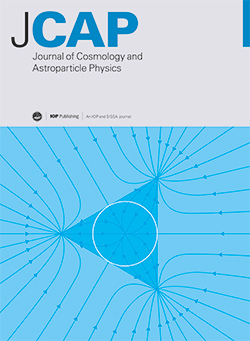Reduced Hubble tension in dark radiation models after DESI 2024
IF 5.3
2区 物理与天体物理
Q1 ASTRONOMY & ASTROPHYSICS
Journal of Cosmology and Astroparticle Physics
Pub Date : 2025-03-12
DOI:10.1088/1475-7516/2025/03/023
引用次数: 0
Abstract
We investigate the presence of extra relativistic degrees of freedom in the early Universe, contributing to the effective number of neutrinos Neff, as Δ Neff ≡ Neff-3.044 ≥ 0, in light of the recent measurements of Baryon Acoustic Oscillations (BAO) by the DESI collaboration. We analyze one-parameter extensions of the ΛCDM model where dark radiation (DR) is free streaming or behaves as a perfect fluid, due to self-interactions. We report a significant relaxation of upper bounds on Δ Neff, with respect to previous BAO data from SDSS+6dFGS, when additionally employing Planck data (and supernovae data from Pantheon+), setting Δ Neff ≤ 0.39 (95% C.L.) for free streaming DR, and a very mild preference for fluid DR, Δ Neff = 0.221+0.088-0.18 (≤ 0.46, 95% C.L.). Applying constraints from primordial element abundances leads to tighter constraints on Δ Neff, but they are avoided if DR is produced after Big Bang Nucleosynthesis (BBN). For fluid DR we estimate the tension with the SH0ES determination of H0 to be less than 3σ and as low as 2σ, and for free-streaming DR the tension is below 3σ if production occurs after BBN. This lesser degree of tension motivates a combination with SH0ES in these cases, resulting in a 4.4σ-5σ evidence for dark radiation with Δ Neff ≃ 0.6 and large improvements in χ2 over ΛCDM, -18 ≲ Δχ2 ≲ -25. Upcoming data releases by DESI and other CMB and LSS surveys will decisively confirm or disfavour this conclusion.求助全文
约1分钟内获得全文
求助全文
来源期刊

Journal of Cosmology and Astroparticle Physics
地学天文-天文与天体物理
CiteScore
10.20
自引率
23.40%
发文量
632
审稿时长
1 months
期刊介绍:
Journal of Cosmology and Astroparticle Physics (JCAP) encompasses theoretical, observational and experimental areas as well as computation and simulation. The journal covers the latest developments in the theory of all fundamental interactions and their cosmological implications (e.g. M-theory and cosmology, brane cosmology). JCAP''s coverage also includes topics such as formation, dynamics and clustering of galaxies, pre-galactic star formation, x-ray astronomy, radio astronomy, gravitational lensing, active galactic nuclei, intergalactic and interstellar matter.
 求助内容:
求助内容: 应助结果提醒方式:
应助结果提醒方式:


